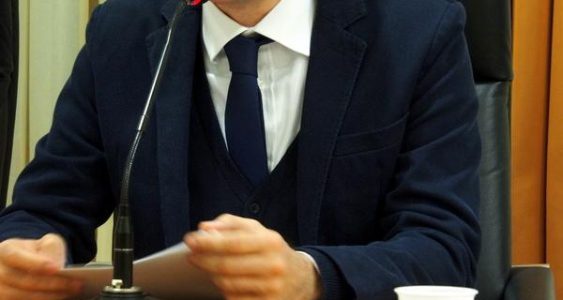Per il secondo anno consecutivo lo storico dell’arte brindisino Teodoro De Giorgio sarà ospite dell’antica e prestigiosa Università tedesca di Regensburg (Ratisbona), dove per lunghi anni ha insegnato il teologo Joseph Ratzinger (papa Benedetto XVI). Dal 3 al 6 luglio prossimi lo stuTeodoro De Giorgio sarà ospite dell’antica e prestigiosa Università tedesca di Regensburg (Ratisbona), dioso relazionerà all’importante convegno interdisciplinare, organizzato dalla Fakultät für Katholische Theologie dell’università ratisbonense e dedicato alla genesi dell’anno liturgico bizantino in epoca tardo antica a Costantinopoli.
L’argomento trattato da Teodoro De Giorgio sarà di particolare interesse, per via anche delle connessioni con la storia brindisina: L’encomio di Gregorio di Nissa in onore del soldato martire Teodoro d’Amasea e il suo influsso sulla tradizione liturgico-iconografica costantinopolitana preiconoclasta. Lo studioso tratterà in dettaglio l’encomio del Nisseno, reputato – in ragione dell’autorevolezza e del prestigio di cui godeva ancora in vita il suo autore – la prima testimonianza storicamente attendibile sulla vita e sulla passione del martire, in grado di influire sulle successive formulazioni agiografiche e sulle redazioni liturgiche delle feste del santo presenti nel calendario bizantino, nonché sulla definizione preiconoclasta dei caratteri iconografici e del principale attributo di Teodoro: il serpente-drago, le cui attestazioni risalgono alla prima metà del VI secolo e che solo a partire dall’XI verrà assorbito da san Giorgio.
Per maggiori informazioni:
https://www.uni-regensburg.de/theologie/liturgiewissenschaft/medien/flyer_gesamt_2018.pdf
https://www.uni-regensburg.de/theologie/liturgiewissenschaft/aktuelles/index.html
http://noek.info/hinweise/595-tagung-towards-the-prehistory-of-the-byzantine-liturgical-year
PROGRAMM
Tuesday 3 July Afternoon
Fundamental Perspectives
– Holger Villadsen, Liturgical Year and Readings in Constantinople according to Severian of Gabala
– Harald Buchinger, Mimetische und amimetische Aspekte bei Severian von Gabala
– Wendy Mayer, Reappraising the homily as a liturgical source: how far can we push the boundaries?ù
Tuesday 3 July 6 pm: Opening and Public Keynote
– Derek Krueger, The ninth-century kontakarion as evidence for the late antique calendar and festive practice in Constantinople
Wednesday 4 July Morning
Christmas Cycle
– Stefanos Alexopoulos, Was there an Organized Catechumenate in Constantinople at the Time of Gregory the Theologian? Looking at Orations 38-40 for Evidence
– Thomas Karmann, Zu den „Weihnachts“-Predigten Gregors von Nazianz
– Nicholas Russo, St. Gregory Nazianzus’ Oration 40 (On baptism)
– Annette von Stockhausen, Das Epiphanias-Fest bei Severian von Gabala – (Methodologische) Überlegungen zum Sitz im Leben einiger seiner Homilien
Easter Cycle I
– Sever J. Voicu, The Ancient Byzantine Lent
– Stefano Parenti & Elena Velkovska, La prequaresima e la quaresima prebizantina: la testimo-nianza dei Vangeli liturgici
– Sergey Kim, Preaching on Palm Sunday in Constantinople and in Antioch: Severian of Gabala and Meletius of Antioch
Wednesday 4 July Afternoon
Easter Cycle II
– Matthieu Cassin, De la Grande Semaine à la Pentecôte dans les Homélies de Léonce, prêtre de Constantinople
– Radu Garbacea, Liturgy and Preaching on Maundy Thursday in Late Antique Constantinople According to Severian of Gabala and Proclus of Constantinople
– Alexandru Liviu Ionita, Θεοκτόνοι ἰουδαῖοι: Patristic Homilies for the Holy Week, Anti-Judaism and the Making of the Byzantine Lectionary
– Richard Bishop, The Pentecost Sermon (CPG 5815) Attributed to Proclus of Constantinople
– Eirini Artemi, The theological and doxological reference to the Resurrection and the Pentecost according to the orations of Gregory Nazianzen XLI and XLV
Thursday 5 July Morning
Marian feasts
– Stephen J. Shoemaker, The Cult of the Virgin in the Liturgy of Late Ancient Constantinople
– Christiaan Kappes, Proclus of Constantinople (or Ps-Basil of Seleucia) Homily 39: Liturgical and Patristic Sources, Lections, and Relation to the Council of Ephesus
– Mary Cunningham, Fifth- and Sixth-Century Byzantine Homilies on the Annunciation: Wit-nesses to an Early Phase of Marian Celebration and Doctrine
– Spyros P. Panagopoulos, The Feast of the Entrance of the Holy Virgin into the Byzantine Li-turgical Calendar: Homiletics and Hymnography in Interaction
– Marco Benini, Hypapante: Vom Christusfest in Jerusalem zum Marienfest in Konstantinopel?
– Innocent Smith, Kosmas Vestitor and the Development of Marian Liturgical Devotion in East and West
Thursday 5 Afternoon
Sanctorale and other celebrations
– Katharina Reihl, Die Heiligen Stephanus, Euphemia und Phokas in Konstantinopel zur Zeit des Johannes Chrysostomus
– Teodoro De Giorgio, L’encomio di Gregorio di Nissa in onore del soldato martire Teodoro d’Amasea e il suo influsso sulla tradizione liturgico-iconografica costantinopolitana pre-iconoclasta
– Daniel Galadza, Sanctorale of Gospel Manuscripts
– Gary Philip Raczka, The Introduction of the Reading of the Gospel of Luke into the Byzantine Lectionary
– Mark Roosien, The readings and processions of early earthquake commemorations in Con-stantinople: homiletic and historical precursors
– Gregory Tucker, Towards the Pre-history of the Conciliar Feasts
– Vitaly Permiakov, Homily of Ps.-Severian of Gabala “On the Dedication of the precious and life-giving Cross” and the Early History of the Feast of Exaltation in Constantinople
Friday 6 July Morning
Hymnography
– Alexander Lingas, Singing Feasts in the Liturgy of Late Antique Constantinople
– Georgia Frank, Singing in the Dark: The Night Vigil as Incubator of Emotions
– Andrew Mellas, “Let us lift up our hearts”: Transforming theology into sacred song in Romanos the Melodist’s On Pentecost
– Damaskinos Olkinuora, Contextualizing Romanos: the problems of his sources and influence on festal homilies
– Mark Morozowich, Patristic Holy Thursday Homilies on the Transgression of Judas: Precursors to Hymnographic Elements?
– Mark Bilby, Festal Breadcrumbs of the Byzantine Eucharist: Patristic Antecedents of the Tro-parion τοῦ δείπνου
– Stig Ragnvald Frøyshov and Thomas Arentzen, The kata stichon hymnography as a source for early Constantinopolitan festal celebrations?
Friday 6 July Afternoon
Complementary Questions
– Byron MacDougall, Theoria in Constantinopolitan Homiletic and the Legacy of Gregory of Nazianzus
– Mikhail Zheltov, Eucharistic miracle stories and annual structures
– Stéphane Verhelst, L’énumération des fêtes du Seigneur dans les homélies byzantines, spécialement à Jérusalem
– Vasileios Marinis, Architecture and Liturgy in the Early Churches of Constantinople: A Re-appraisal
– Maria Xenaki, Commemorating the Dead in Late Antique Constantinople: Epigraphical Sources
– Alexander Rentel, At the crossroads of canonical process and liturgical rites: the election and ordination of bishop in the canonical corpus
Centro Studi Teodoriani
Pontificia Basilica Cattedrale
Piazza Duomo
72100 Brindisi



No Comments